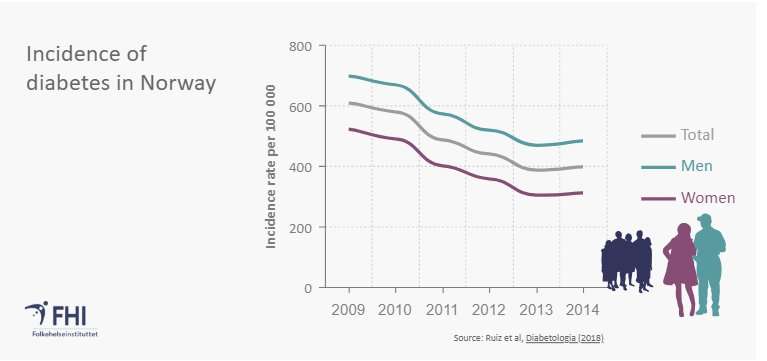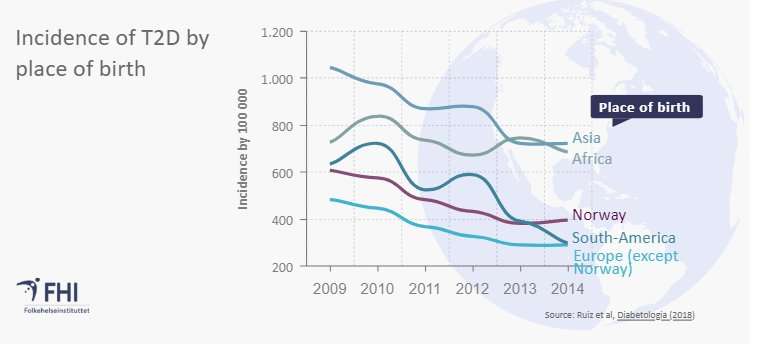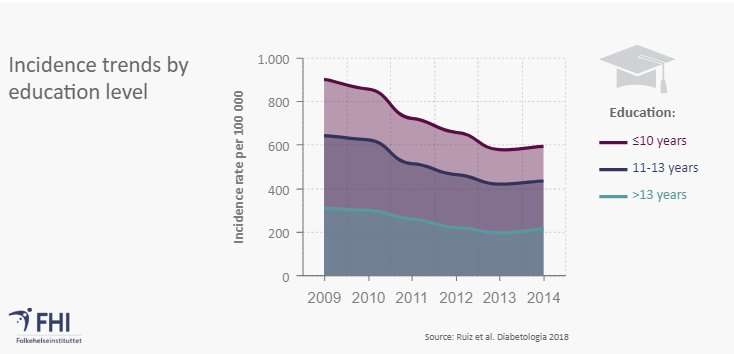Decrease in new type 2 diabetes cases in Norway

Type 2 diabetes is one of the major chronic diseases and the patient group has increased year upon year, "therefore, it is great to see the decline in the number of new cases among all the age and education groups, and among most of the immigrant groups," says Paz Lopez-Doriga Ruiz, main author of the study and Ph.D. fellow at the Norwegian Institute of Public Health (NIPH) and Oslo University Hospital.
"We do not know if the decline in 2009-2014 was short-lived and whether the numbers have gone up or down since then. We hope to continue our research with annual updates that will become part of the Institute's health surveillance. It is of great interest to follow the development of type 2 diabetes over time," she adds.
From 16,000 to 11,000 per year
Researchers at the Norwegian Institute of Public Health calculated the number of new cases per year by gender, age, education level and country of birth. This is the first time this has been done for Norway. They also made new calculations for the number of people living with the disease.
As part of the research, data were linked from three national health registries, the Norwegian Prescription Database, the Norwegian Patient Registry and the primary care database (KUHR), and these were linked to Statistics Norway and the National Registry.
The results show that:
- The number of new cases declined from 609 per 100,000 in 2009 to 398 per 100,000 in 2014, see Figure 1. In actual terms, there was a decline from over 16,000 new cases in 2009 to 11,000 in 2014.
- Overall, 75,000 people developed type 2 diabetes during the period from January 2009 to June 2014, an average of 13 600 cases per calendar year.
The number of new cases is decreasing among all age groups, among those with high and low education (figure 2) and among immigrants (figure 3). People born in Asia, Africa and South America are at increased risk, and there was a slight decline in these groups, apart from the group born in Africa.

Lifestyle changes?
The researchers cannot explain the reasons for the decline but they believe they are associated with lifestyle changes. New cases of myocardial infarction (heart attacks) have also declined, which is probably related to smoking, physical activity and diet.
The paradox is that while we see an increase in obesity in the population, there is a decline in new cases of type 2 diabetes and myocardial infarction. Perhaps the sum of all factors is moving in a positive direction.
Over 195,000 had type 2 diabetes in 2014
The number of newly diagnosed cases comes in addition to those already living with type 2 diabetes. During the period 2009-2014, the number of people with type 2 diabetes increased in the population.
"The number of new cases can change quickly but we need at least ten years of decline in the number of new cases before we see a noticeable decline in the number of people living with the disease," says Lars Christian Stene, researcher at the Norwegian Institute of Public Health and co-author of the study.
He points out that the average patient with type 2 diabetes is diagnosed at about 60 years of age. With good medical treatment, the majority will live for at least 20 years with the disease.
- In 2014, it was calculated that 195,000 people in the 30 to 89 year age group had the disease.
- On average, more than 1 in 20 people between 30 and 89 years had type 2 diabetes in 2014. The proportion increased from 4.9 percent in 2009 to 6.1 percent in 2014.
Due to population growth and the increase in life expectancy, the number of people living with type 2 diabetes has continued to rise during the study period. Data from the Prescription Database support this, but these data exclude people who are treated with lifestyle interventions.
In total, approximately 3 out of 4 people are treated with blood glucose-lowering drugs. The others are treated with lifestyle interventions.

Prevalence in different age groups
Figure 4 shows the proportion living with type 2 diabetes in different age groups. The figure shows that about 1 in 100 in the 30-39 year age group and over 2 in 100 in the 40-49 year age group live with the disease. In the over-60 year age group, 10-15 percent are affected.
Need annual statistics
The analysis took a long time because researchers could not obtain data from a single registry. They need to link data from three health registries, something that requires significant resources in addition to long case processing time in each registry.
There is also a proportion with undetected diabetes in the population. The disease often has diffuse symptoms, and it may take time for people with unclear symptoms to contact their doctor. The proportion of undetected diabetes has probably decreased, due to increased awareness of the disease and simpler diagnosis, although this is uncertain.
About the study
The data were obtained from three national registries for the period 2009-2014; the KUHR (the primary care database), the Norwegian Patient Registry and the Norwegian Prescription Database. They were linked to information from Statistics Norway and the National Registry.
The study includes the 30-89 year age group, a total of 3.2 million people, by gender, age, education and country of birth. 75,496 newly diagnosed cases of type 2 diabetes were included in the analysis.
The purpose was to analyse the trend in new cases per year (incidence) and total numbers living with type 2 diabetes (prevalence), as well as to see how many received blood glucose-lowering drugs, or treatment without drugs.
More information: Paz L. D. Ruiz et al. Decreasing incidence of pharmacologically and non-pharmacologically treated type 2 diabetes in Norway: a nationwide study, Diabetologia (2018). DOI: 10.1007/s00125-018-4681-4



















